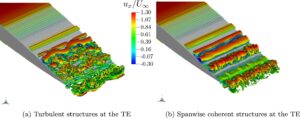The flow over a NACA0012 airfoil at a moderate Reynolds number Re = 5×10^4 and angle of attack of α = 3 deg. is investigated using the lattice-Boltzmann method (LBM). The LBM solutions are computed in direct numerical simulation (DNS) mode, i.e., without employing subgrid or wall models. A validation is performed against a Navier-Stokes wall-resolved large eddy simulation, and good agreement is achieved between the different approaches, showing that the LBM can provide accurate solutions of boundary layers under transitional regime, but with a significant computational cost reduction. A laminar separation bubble (LSB) forms over the suction side of the airfoil, leading to intermittent vortex shedding that impacts transition to turbulence and the generation of strong spanwise-coherent vortices. Different shedding patterns are observed including the advection of single vortical structures and pairing of two vortices, which may or may not break into finer turbulent scales. Such flow features are characterized by 2D and 3D events that directly impact the sound generation by the trailing edge. Frequency and amplitude modulations from the LSB lead to a noise spectrum with a main tone plus equidistant secondary tones, and a time-frequency analysis shows that the main tones may switch frequencies due to intermittency. This research advances in the comprehension of the LSB behavior in transitional airfoil flows, impacting the performance and noise generation of blades and propellers.

Bernardo Luiz Ribeiro, Cayan Dantas, William Wolf, Intermittency of a transitional airfoil flow with laminar separation bubble solved by the lattice-Boltzmann method, Aerospace Science and Technology, Volume 158, 2025

